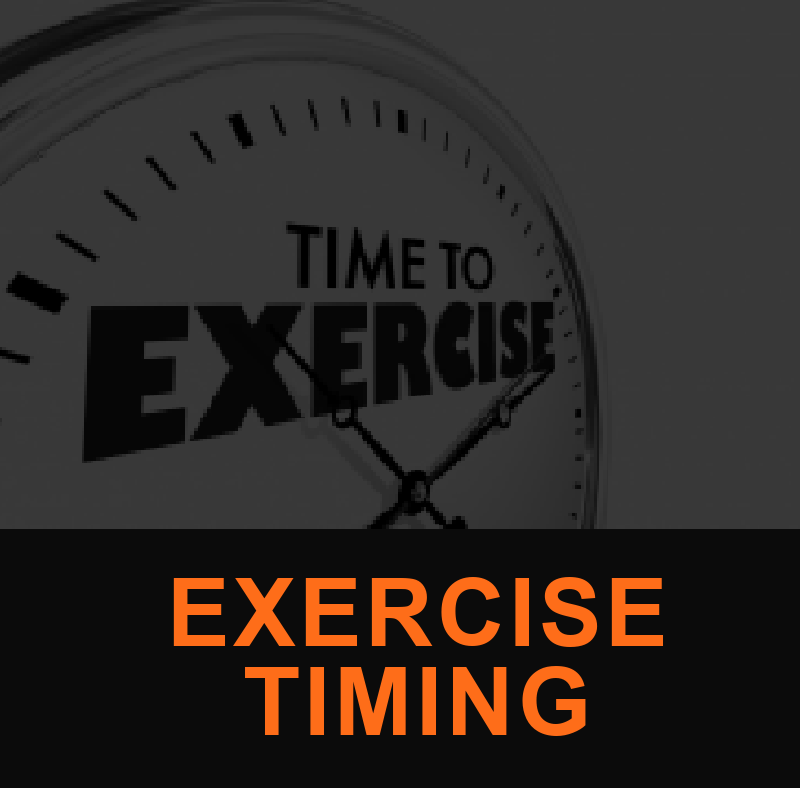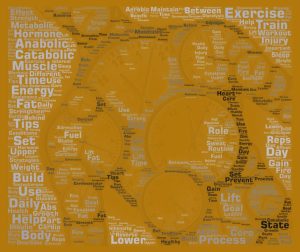
A client may ask the professional trainer for advice about optimal exercise timing. Should they work out first thing in the morning? After breakfast? What about before bed?
As with many factors for individualized physical fitness, “It Depends” is a fitting approach. Variables to consider are depicted in this word cloud for Exercise Timing, including ones for your older clients.

Circadian rhythm and sarcopenia (overweight) factors should be considered when designing an exercise program with regard to older clients (aged fifty-plus).
Instances:
One could contrast the goal of stamina-building for a Medicare-aged woman of ectomorphic body type with they hypertrophy goals of a 30-something male mesomorph as key variables for exercise timing.
Or, one could consider an older mesomorphic client who just started 14- hour intermittent fasts, hoping to lose weight with catabolic morning workouts.
Additionally, one could consider a very athletic elder client who wants to build muscle with anabolic workouts.
Trainers can design a dependent workout for each, factoring in individual preferences and body factors.
When Should a Client Exercise?
A trainer’s exercise design program should credibly consider “WHEN” on that specific day the client is:
- most capable of achieving her or his goals
- best periods to intentionally metabolize glucose or fat as a primary fuel
Encourage clients to get their workouts done habitually as a principal consideration. Getting a workout in takes precedence over the time of day a workout takes place.
As a client advances in age, dietary absorption of macronutrients, sleep patterns, and type of “metabolic burning” may be quite different than for a younger client. Thus, exercise timing has age-dependent variables.
Older clients generally retire to bed earlier. They rise earlier and generally do NOT fast. And unfortunately, many older clients already suffer from sarcopenia.
Timing considerations highlighted ahead:
a. Hormonal considerations for both anabolic and catabolic states and exercise
b. Circadian rhythm factors for planned exercise types
c. Intermittent fasting
d. Body type dependencies.
Hormonal Factors for Exercise Timing
Keen understandings of anabolism and catabolism as metabolic processes can aid a client’s fat loss, and/or skeletal muscle gains.
Anabolic hormones which support, repair, and build tissue for all clients are:
- estrogen
- insulin
- growth hormone (IGF-1 is a vital human growth hormone that supports tissue growth and development, plus recovery and healing)
- testosterone
Key catabolic hormones, which cause tissue breakdown and can support autophagy are:
- adrenaline
- cortisol
- cytokines
- glucagon
When a client is in an anabolic state, she or he is building and maintaining muscle mass. This is key for most elder clients (and truly, for all of our clients).
When a client is in a catabolic state, she or he is breaking down or losing overall mass, which likely includes both fat and muscle.
A client may want to prioritize either anabolic and catabolic exercises on a given day. Recall that each client is different; so the planned volume, intensity, and tempo of strength and cardio routines may shift over time and will change from one client to the next one.
Notes:
- Restorative sleep can notably improve baseline levels of anabolic hormones like testosterone.
- Hormone perturbations, like thyroid conditions, poor insulin sensitivity, or Type II Diabetes, affect these processes and one’s overall metabolism.
Circadian Rhythms of Clients
Researchers know that “circadian rhythms” have evolved into a complex physiological and molecular system demonstrated by sleep-wake cycles, daily fluctuations in body temperature, blood pressure, cellular regeneration and behavior such as food intake and alertness levels.”
“At least 50 percent of our metabolism is circadian…It makes sense that exercise would be one of the things affected.”
Paolo Sassone-Corsi, PhD.
“Early bird” or “morning lark” clients may prefer morning workouts when their catabolic hormone levels tend to be higher.
Some late-night owls lean toward afternoon or evening workouts as matters of preference – when their anabolic hormone levels tend to be highest each day. Trainers should be aware of the “when” workout preferences of their clients based in part on their evolved circadian rhythms.
Having considered hormone levels, then daily rhythms as factors for exercise timing, how might a client’s last macronutrient absorption come into play?
Intermittent Fasting
Truths:
- Fasting, (whether intermittent or extended), time-restricted eating, or consistent energy restriction, can impact a client’s workouts and quality of life in both favorable and unfavorable ways.
- An early bird client can eat before a morning workout to help shift the metabolic state from catabolism to anabolism.
- As many elder clients are morning larks, an 80-100 calorie “break of the fast” may help avoid catabolism and further sarcopenia.
- If a client has fat loss as a primary fitness goal, then proceed judiciously with catabolic workout recommendations.
Body Type Dependencies
General correlations between Somatypes and types of “fat-burning” capacity relate to the optimal timing of client exercise.
As broad guidelines:
a. Thin Ectomorphs are metabolically conditioned to burn their stored fat (Dr. Jonny Bowden labels this Level 4 fat burning) As ectomorphs advance in age or don’t exercise for a period, they may evolve to Level 3 fat-burning metabolisms.
b. Sturdy Mesomorphs can generally use both stored carbohydrates and fat efficiently as Bowden Level 3 fat burners.
c. Plump Endomorphs are not metabolically efficient at burning their stored fat (as Dr. Bowden’s Level 1 fat burners).
The Verdict on Exercising Timing
Although exercise timing is almost everything, habitual motion is a primary factor for a client’s progressive workout success. As individually shaped by a client’s
- hormones
- daily rhythms
- fasted state
- somatype
Two broad approaches for Exercise Timing are:
- Exercise in the morning: to lose weight, boost mood, better keep to a routine, and maintain strength.
- Exercise in the late afternoon or evening: to avoid injury, perform your best, and probably enjoy the workout a bit more.
Exercise Timing should accommodate an individual’s inherent or developed metabolism for sugar and fat in addition to daily preferences and habits.







